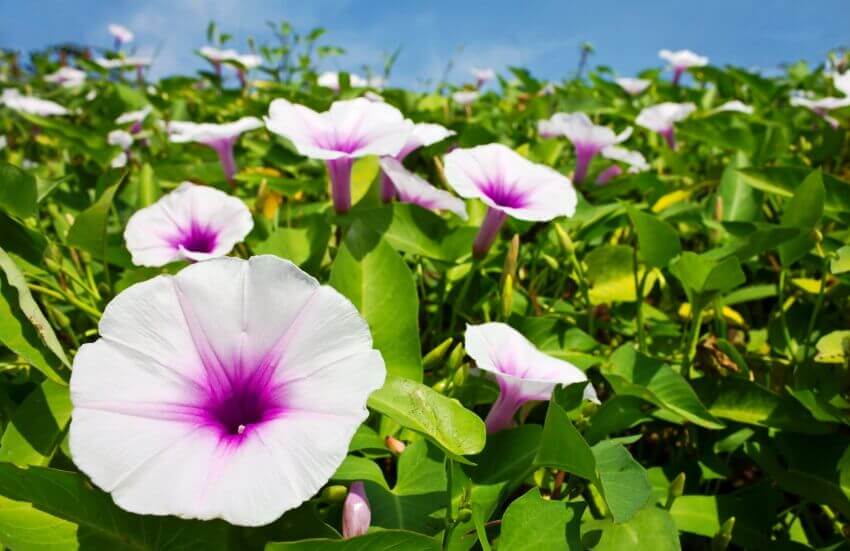The gorgeous funnel-shaped blossoms of morning glory plants are lovely complements to any garden, even though some species are regarded as weeds. If you like this flower, be aware that both people and pets may be poisoned by it.
This article discusses the morning glory flower’s characteristics, history and also toxicity to humans and animals.
If you are interested in this topic, you can also read
<<Poisonous Plants For Children>> and <<Are Sweet Peas Poisonous? >> articles.
About morning glory
Ipomoea also referred to as morning glory, is a sizable genus that contains 500 different species of climbing shrubs and vines that can be annual or perennial. Morning glory plants can be found in both warm temperate and tropical regions. Mexico and Central America are their original habitats [1].
Morning glories have simple or palmately lobed leaves, frequently with long, twining petioles. Depending on the species and cultivar, flowers can be white, purple, blue, pink, or red. Morning glories have large, beautiful, funnel-shaped flowers. Their Fruits are ovoid capsules with 1 to 4 seeds within them.
Common morning glory vines quickly expand up to 12 feet or more in height during the season by using their tendrils to cling to neighboring supports. They can be started from seed about a month before the last spring frost, and as they prolifically self-sow, it is highly likely that they will return the next year. Unwanted seedlings are often easy to remove, while some gardeners find them overly invasive.
Common morning glory has trumpet-shaped flowers with vibrant colors and a faint scent that attract butterflies and hummingbirds. The buds’ unusual name comes from the way they are tightly twisted up and then unfurl as the sun touches them in the morning.
Morning glory and toxicity
Morning glory seeds are lethal, especially if taken in large amounts. They must be kept away from kids and animals since they are potentially harmful. They contain lysergic alkaloids, a toxin that can make people anxious and uncoordinated. The leaves might make you feel sick or vomit if you consume them.
In particular, the seeds are rich in indole alkaloids that resemble ergot alkaloids. Ipomoea tricolor seeds include lysergic acid, isolysergic acid, and chanoclavine as their main alkaloids. The Ipomoea tricolor cultivars “Heavenly Blue,” “Pearly Gates,” “Summer Skies,” “Blue Star,” and “Wedding Bells” contain lysergic acid.
Ipomoea alba (Moon vine), Ipomoea coccinea (red morning glory), Ipomoea nil (Scarlet O’Hara), and Ipomoea xsloteri (cardinal climber) are a few of the species planted as garden ornamentals with low lysergic acid contents. Depending on how many seeds are thoroughly chewed and eaten, the side effects can be hallucinations, incoordination, lethargy, and diarrhea[2].
It has been discovered that the Ipomoea species from Australia (Ipomoea carnea) and Africa contain the alkaloids swainsonine and calestegins, which block the activity of the cellular enzyme mannosidase and result in lysosomal storage disorder. Other species such as Astragalus, Oxytropis (locoweeds), Convolvulus (bindweed), and Calestegia (hedge bindweed) contain the same alkaloids. Moreover, ruminants that consume the leaves and seeds of these invasive morning glory species might exhibit anemia and hepatic necrosis symptoms.
Another species of morning glory is moldy sweet potato (Ipomoea batatas) which contains furan compounds, including ipomeanol. Consumption of sweet potatoes can cause severe respiratory disease in cattle.
Use of morning glories throughout history
The South American peoples’ priests used to consume morning glory seeds, also known as tlitlitzin. They used its mildly changing characteristics to aid their divination and communicate with the gods.
The seeds were gathered, crushed, and soaked in water before consumption. Since the locals thought the god genuinely existed, Spanish chroniclers attempted to hide information about the seeds’ usage in divination in the middle of the sixteenth century by labeling it as devilry [3].
According to some theories, the potential victims of human sacrifice would be given a drink of tlitlitzin to make them numb to the pain of having their chests sliced open with an obsidian knife and their hearts pulled out as an offering.
Are morning glories poisonous to adults and children?
The morning glory’s seeds are toxic to humans. Most adults do not eat morning glory’s poisonous seeds, but sometimes children do. It is safe for children to consume the blooms, But they should not eat their seeds.
If they consume a lot of the morning glories seeds, it might be harmful since these seeds contain LSD-like chemical compounds. Consumption of these toxic seeds has a wide spectrum of symptoms, from diarrhea to hallucinations. Twenty to fifty seeds are regarded as a mildly hazardous dose in humans.
The leaves may also disturb the stomach, resulting in nausea and vomiting. Nevertheless, as a famine meal, the roots, stems, and leaves may be used in limited quantity.
Are morning glories poisonous to dogs?
Yes, morning glories are poisonous to dogs. However, as numerous morning glory seeds must be thoroughly eaten and swallowed, dogs are unlikely to become ill from eating a small amount of these seeds.
Are morning glories poisonous to cats?
Yes, morning glories are poisonous to cats. However, Cat poisoning is uncommon, as many morning glory seeds must be thoroughly digested and ingested.
Clinical Signs and treatment
The affected animal might exhibit symptoms such as lethargy, lack of coordination, aberrant behavior, and diarrhea when a hazardous dosage of the lysergic acid found in morning glory seeds is consumed. To treat such conditions, emetics, and purgatives may be used to flush the digestive tract of the seeds. In a very depressed or unconscious animal, emesis should be utilized with caution.













